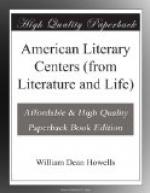got in its work with notable effect at some points.
This began, I believe, with the local dramas of Mr.
Edward Harrigan, a species of farces, or sketches of
character, loosely hung together, with little sequence
or relevancy, upon the thread of a plot which would
keep the stage for two or three hours. It was
very rough magic, as a whole, but in parts it was
exquisite, and it held the mirror up towards politics
on their social and political side, and gave us East-Side
types—Irish, German, negro, and Italian—which
were instantly recognizable and deliciously satisfying.
I never could understand why Mr. Harrigan did not
go further, but perhaps he had gone far enough; and,
at any rate, he left the field open for others.
The next to appear noticeably in it was Mr. Stephen
Crane, whose Red Badge of Courage wronged the finer
art which he showed in such New York studies as Maggie:
A Girl of the Streets, and George’s Mother.
He has been followed by Abraham Cahan, a Russian Hebrew,
who has done portraits of his race and nation with
uncommon power. They are the very Russian Hebrews
of Hester Street translated from their native Yiddish
into English, which the author mastered after coming
here in his early manhood. He brought to his
work the artistic qualities of both the Slav and the
Jew, and in his ‘Jekl: A Story of the Ghetto’,
he gave proof of talent which his more recent book
of sketches—’The Imported Bride groom’—confirms.
He sees his people humorously, and he is as unsparing
of their sordidness as he is compassionate of their
hard circumstance and the somewhat frowsy pathos of
their lives. He is a Socialist, but his fiction
is wholly without “tendentiousness.”
A good many years ago—ten or twelve, at
least—Mr. Harry Harland had shown us some
politer New York Jews, with a romantic coloring, though
with genuine feeling for the novelty and picturesqueness
of his material; but I do not think of any one who
has adequately dealt with our Gentile society.
Mr. James has treated it historically in Washington
Square, and more modernly in some passages of The
Bostonians, as well as in some of his shorter stories;
Mr. Edgar Fawcett has dealt with it intelligently
and authoritatively in a novel or two; and Mr. Brander
Matthews has sketched it, in this aspect, and that
with his Gallic cleverness, neatness, and point.
In the novel, ‘His Father’s Son’,
he in fact faces it squarely and renders certain forms
of it with masterly skill. He has done something
more distinctive still in ‘The Action and the
Word’, one of the best American stories I know.
But except for these writers, our literature has hardly
taken to New York society.
IV.




